 Get the Genesis
of Eden AV-CD by secure
internet order >> CLICK_HERE
Get the Genesis
of Eden AV-CD by secure
internet order >> CLICK_HERE
Windows / Mac Compatible. Includes live video seminars, enchanting renewal songs and a thousand page illustrated codex.
 Get the Genesis
of Eden AV-CD by secure
internet order >> CLICK_HERE
Get the Genesis
of Eden AV-CD by secure
internet order >> CLICK_HERE
Windows / Mac Compatible. Includes
live video seminars, enchanting renewal songs and a thousand page
illustrated codex.
 Return to Genesis of Eden?
Return to Genesis of Eden?
Medicinal plant 'fights' Aids Friday, 30 November, 2001, 08:49 GMT By Carolyn Dempster in Johannesburg
A South African indigenous medicinal plant may hold the key to the treatment of millions of poor people living with HIV and Aids, helping them turn a death sentence into a chronic illness.
For the first time in South Africa's medical history, the plant, Sutherlandia Frutescens, sub-species Microphylla, is to undergo clinical trials to assess its immune-boosting properties.
The Medical Research Council will conduct the trials early next year and results are expected within three to six months.
Anecdotal evidence is already mounting, suggesting that this plant can improve the quality of life of thousands of people both with HIV and full-blown Aids.
Sutherlandia Frutescens grows wild in the Western Cape and in the hills of Zululand.
Cancer bush
A particular variety of the plant has been used for centuries as a potent medicine by South Africa's indigenous San people who call it "Insisa" - the one that dispels darkness. They used it as an energy booster and a powerful anti-depressant.
Zulu sangomas or traditional healers know it as "Unwele", the great medicine that was used to ward off the effects of the devastating 1918 influenza pandemic which claimed 20 million lives worldwide.
The Tswana people know it as "Mukakana" for its power in treating gonorrhoea and syphilis, while the Afrikaners call it the "Kankerbossie" or cancer bush, because of its properties in treating people suffering with internal cancers and wasting.
 Molecular combination
Molecular combination
A local company specialising in the development of indigenous plant medicines, Phyto Nova, first started researching the bio-chemical properties of Sutherlandia about three years ago.
A multi-disciplinary team headed by Dr Nigel Gericke, a botanist, medical doctor and indigenous plant specialist, found that Sutherlandia contained a powerful combination of molecules which have been identified and used in the treatment of patients with cancer tuberculosis, diabetes, schizophrenia and clinical depression and as an antiretroviral agent.
Phyto Nova were so convinced that Sutherlandia could be used as a tonic for people infected with HIV and Aids, that they contracted farmers to plant acres of the bush, to prevent wild supplies being over-harvested. They have been manufacturing high quality Sutherlandia tablets, gel and powder.
Having determined that the product was safe when administered with a balanced food diet, the company distributed Sutherlandia to Aids patients.
Quality of life
"Anecdotally we are accumulating evidence that wasted patients with Aids, TB and cancer pick up weight, regain energy and appetite," says Dr Gericke.
"The claim we are making on the basis of this, is that we can significantly and dramatically improve the quality of life of many ill Aids patients... We are certainly not making the absurd claim that Sutherlandia is a cure-all or a cure for Aids."
Whatever comes of the clinical trial, word of the plant's properties is already spreading among South Africa's traditional healers.
At the same time as Phyto Nova was conducting its research, one of the country's most venerated traditional healers, Dr Credo Mutwa, 80, was using Sutherlandia to treat Aids patients.
"My aunt Minah, who is 103 years old, told me that we should use the great medicine against Aids," said Dr Mutwa. "I said to her: 'But aunt, the white people tell us there is no cure for this disease'.
"And my aunt said: 'For every disease there is a treatment. Try this medicine'. And I tried it."
'Near-miraculous'
"I have treated people who were told by the doctors at the hospital to 'go home and die' and they are still alive today, three years after they should have died. This plant is near-miraculous, I can say that with certainty," he says.
Testimony to the efficacy of the plant continues to mount.
Anne Hutchings, an ethno-botanist and lecturer at the University of Zululand has been using Sutherlandia, together with a range of other indigenous plant medicines, to treat Aids patients who attend the weekly Aids clinic at Ngwelezane Hospital.
She has 176 patients who all testify that Sutherlandia has helped them to live a fuller, healthier and more productive life.
No response
 In the Northern Cape town of Kuruman,
nurse and sangoma, Virginia Rathele is using Sutherlandia at her
clinic to treat more than 300 Aids patients.
In the Northern Cape town of Kuruman,
nurse and sangoma, Virginia Rathele is using Sutherlandia at her
clinic to treat more than 300 Aids patients.
She says an integral part of the treatment is to tell patients to eat healthily. "Sutherlandia does not work properly just on a diet of porridge. You have to have vegetables," she said.
One client, who weighed 26kg and was close to death in April this year, now weighs 45kg and is helping Ms Rathele run the clinic.
Patents cannot be taken out on plants which have well-documented folk use, which means that Sutherlandia should remain accessible to anyone.
At present, one month's supply of Phyto Nova tablets costs a little under $2.50 and two months' supply of the powder form of the medication can be bought for under 50 cents.
Phyto Nova has approached the South African Government in a bid to persuade them to grow the plant on a massive scale for use in public health treatment.
So far they have had no response.

Harvesting wild flowers in Flower Valley
South Africa's floral riches at risk Thursday, 18 October, 2001, 17:09 GMT 18:09 UK
By Alex Kirby BBC News Online environment correspondent
A UK-based group, Fauna and Flora International (FFI), is working with South African colleagues to save the unique Cape floral kingdom.
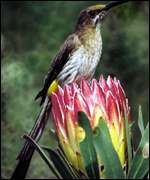 Slightly larger than Scotland,
it contains about 8,500 species, 5,800 of them found nowhere else
on Earth.
Slightly larger than Scotland,
it contains about 8,500 species, 5,800 of them found nowhere else
on Earth.
But 1,400 species are thought to be critically endangered and close to extinction. Now, conservationists have worked out a plan to protect the area against the multiple threats it faces.
There are six floral kingdoms on Earth - the Antarctic, Australasian, Boreal, Neotropic, Palaeotropic, and the Cape. Each is distinguished by the number of endemic species it contains (species found nowhere else).
The Cape floral kingdom is botanically more diverse than the richest tropical rainforest. It occupies about 90,000 square kilometres (35,000 square miles) at Africa's southern tip, stretching along the coast either side of the Cape of Good Hope.
The main plant community is known as the fynbos, Afrikaans for "fine bush", and a reference to the fine-leaved shrubby species that make up much of the vegetation. The fynbos constitutes 80% of the Cape floral kingdom.

Fire-dependent plants
The fynbos also contains many broad-leaved species, and it resembles other vegetation types like the Mediterranean maquis. It contains more than 7,000 species, nearly 5,000 of them endemic.
It produces a huge and colourful display of wild flowers, and is the origin of familiar plants like proteas, geraniums and freesias.
Many fynbos plants depend on periodic fires for their survival, some needing the heat for their seeds to germinate and to recycle the scarce nutrients locked up in the woody growth.
 Now, though, the fynbos faces several
threats, including competition by invading species. Some were
originally imported as commercial crops. They destroy the established
vegetation and damage the water catchments.
Now, though, the fynbos faces several
threats, including competition by invading species. Some were
originally imported as commercial crops. They destroy the established
vegetation and damage the water catchments.
Other problems include urban expansion, pollution, over-extraction of water, and the conversion of land for agriculture.
Conservation model
In 1999, FFI bought Flower Valley, which had for years supported a wild flower-harvesting business but which was on the point of being ploughed up and used for vineyards.
FFI introduced sustainable harvesting methods, and the valley is now a model for fynbos conservation over a much wider area, as well as providing 60 jobs.
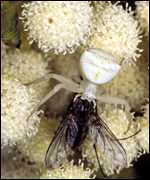 And to secure the future of the
entire kingdom the South African Government and a range of partners
have developed a comprehensive scheme: Cape, the Cape Action Plan
for the Environment.
And to secure the future of the
entire kingdom the South African Government and a range of partners
have developed a comprehensive scheme: Cape, the Cape Action Plan
for the Environment.
They have asked the Global Environment Facility for $35 m (£25 m) over the next 20 years, when they hope to have conserved or restored the kingdom's biodiversity.
Attracting tourists
Cape, the first conservation strategy developed for an entire biodiversity hotspot, aims to establish a network of reserves, and to work towards sustainable yields.
Khungeka Njobe works for South Africa's National Botanical Institute. She told BBC News Online: "What's unique about Cape is the level of support it's got from everyone involved, from the cabinet down.
"It's more a sustainable development strategy than one about biodiversity alone, and I think it can attract a lot more tourists to the kingdom.
"We're a very environment-conscious country, and I don't doubt we can cope with tourists in a sustainable way."
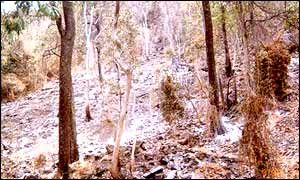
Thursday, 17 January, 2002, 21:54 GMT Ethiopia's forests face extinction
Flora and fauna face total destruction in Ethiopia By Nita Ballah in Ethiopia
Ethiopia could have no natural forests left by 2020, according to the author of a new UN report on forest fires in Ethiopia.
Mr Dechassa Lemessa, co-author of the report "Forest Fires in Ethiopia" complied for the UN Emergencies Unit for Ethiopia (UN-EUE), says that as a result of decades of devastating forest fires, less than 3% of the entire country is now covered with trees - prompting fears of an impending environmental disaster.
"Four decades ago, 40% of Ethiopia was covered by forests, now this has dropped to only 2.7%," says agriculturist Mr Lemessa.
"The decrease of Ethiopia's natural forests is happening at an alarming and furious rate.
"Ethiopia is currently losing 200,000 hectares every year as a result of forest fires.
And he warns: "If something is not done soon, we estimate that there will be no forest land in 15 to 20 years."
 Forests degradation
Forests degradation
According to the four-month study conducted by Mr Lemessa and Mr Matthew Perault, human interference mainly for subsistence and economic reasons, is the most important reason for the fast depletion and serious degradation of natural forests.
"Ethiopian farmers have been using fire as a means of production and a farming tool for a long time", says Lemessa. "Every year, just before the start of the rainy season, when farmers start preparing their land, it is common to see deliberately set fires."
Although the farmers generally control the fires, there have been many fires that have broken out on a much larger scale and brought serious economic, political, social and environmental shock and devastation in Ethiopia.
Nature in blazes
In January 2000, forest fires raged for over three months in Ethiopia's south-western forests of Bale and Borena.
More than 15,000 people nationally and internationally were mobilised to fight the fires and officials estimate that 169,589 work days were lost in attempts to stop the fierce blaze.
Despite all the efforts, more than 300,000 hectares of natural forest land was consumed by the rampaging fires.
Beside the highland forest, the fires also burned food and cash crops like coffee.
Livestock and endemic wildlife were killed or fled the area, and flora and fauna were destroyed.
But this is just a small fraction of the damage caused by wildfires.
Irreparable ecological harm
According to the UN report, forest fires represent a serious threat to the country's most vital natural resources and the elimination of the indigenous species does "irreparable ecological harm".
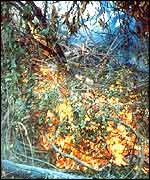 "Forest fires
affect soils physically, biologically and chemically.
"Forest fires
affect soils physically, biologically and chemically.
"Fires may radically change the environment, which significantly affects an ecosystem's biodiversity because they have such a comprehensive impact on soils", Mr Lemessa says.
The report also estimates the economic repercussions of forest fires are devastating for the country.
The total cost of the damage of the Bale and Borena fires was approximately US $39 million, too much for a poor country like Ethiopia.
Economic loss
In a country almost exclusively dependent on subsistence agriculture for economic sustenance, the report's authors say large fires and the destruction of many critical highland forests means a substantial loss of economic potential.
According to the report, the tiny fraction of forested land left contributes more than 2% to Ethiopia's Gross Domestic Product (GDP), proving its value as an asset to be preserved.
The report describes the government's attempts at trying prevent forest depletion as "futile and unsuccessful" and states that even after the Bale and Borena fires, Ethiopia "does not give adequate attention to efficiently protecting its last natural forest resources".
The authors believe one way is providing farmers with conservation techniques that also increase production.
They say increasing local awareness of the long-term benefits of environmental conservation could be one solution.
Mission impossible
The findings show that preventing the destruction of all of Ethiopia's forests may be impossible as "Ethiopia's forest fires are primarily human in origin, the prevention of future fires is a difficult, daunting task."
Mr Lemessa and Mr Perault believe that one way of preventing the fires is to provide farmers with conservation techniques that also increase production.
They say increasing local understanding of the long-term benefits of environmental conservation could be one solution.
"We can improve traditional practices and help the rural communities benefit from the tourism that is drawn to forested areas", says Mr Lemessa.
Land tenure
The report authors call for more roads to allow access to remote areas to tackle the fires and firebreaks and towers as an additional safety measure.
But the key, they say, is taking the land, which is state owned and giving it to local communities who would then have a greater incentive and responsibility to care for the land.
"Land tenure is perhaps the single most important factor in natural resources management, environmental degradation and fire use.
"Without changing ownership either literally or symbolically to give local communities a greater sense of investment in the land, environmental disasters will continue and the 2.7% of the country that is forested will rapidly diminish".
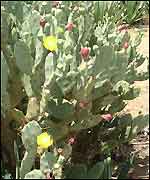 Wednesday,
16 January, 2002, 16:59 GMT Political threat to Madagascar biodiversity
Wednesday,
16 January, 2002, 16:59 GMT Political threat to Madagascar biodiversity
Ifotaka village girls know little of elections or conservation By Ruth Evans in Madagascar
Southern Madagascar's spiny forest is like a fantasy land, the driest, wildest and most startling of the island's unique ecosystems.
Most of the 200,000 plus species of plants and animals found here are found nowhere else on earth and the island has been classified as one of the world's top three "hotspots" for biodiversity.
Impenetrable thickets of weirdly adapted succulents and cactus plants, are peppered with pachypodia and bloated giant baobabs.
The forest is also home to the white sifaka lemur, who depend on the spiny didierea trees for their habitat, eating the leaves and fruits.
Yet Madagascar is one of the poorest and most environmentally challenged countries in the world.
And loss of habitat is a serious problem, especially when combined with damage from the periodic cyclones, droughts and locusts that have hit the island.
Village life
Against a backdrop of prickly octopus arms of didierea reaching into a cloudless sky, two weary girls drop their bundles of wood on the river bank and wash their sweating faces.
It has been a long hard haul through the relentless heat, collecting
wood for cooking from the 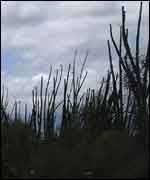 dry
forest.
dry
forest.
In front of them, across the shallow river which they now wade across, lies the village of Ifotaka, a dry, dusty and impoverished place where the houses are built entirely of planks of didierea.
The forests have a spiritual significance for most Malagasy, and it is a measure of people's desperate poverty that they are now destroying these forests and species at such an alarming rate.
In Ifotaka, there is no TV, just one newly acquired wind-up radio for the whole village.
The children do not go to school, the village pump has broken and their only transport is by ox and cart.
And the girls are not even aware that a presidential election has been taking place, let alone what the candidates are promising.
Elections
In Madagascar's capital, Antananarivo, election talk has taken over.
Last week it was convulsed by demonstrations demanding that opposition candidate Marc Ravalomanana be declared the outright winner of the inconclusive December presidential elections.
A recount has now been ordered.
Mr Ravolomanana, the current mayor of Tana and a self-made dairy millionaire, has promised to raise living standards for Madagascar's 16 million people, but even if he is elected, meeting those expectations may not be such an easy task.
Madagascar is the eleventh poorest country in the world, and an estimated 75% of the island population lives below the poverty line.
When President Didier Ratsiraka resumed power back in February 1997, he outlined plans for what he called a "humanist and ecological republic", based on "rational exploitation" of the country's natural resources.
It made a refreshing change from the former Marxist dictator that had first came to power in 1975, but opponents argued that Mr Ratsiraka was merely trying to steal nature's mantle, since Madagascar already is an ecological paradise, a treasure-trove of some of the most unique flora and fauna in the world.
But the statistics are stark: In the past 40 years Madagascar's population has doubled and the forest area has halved.
There is now only about 10% of the original forest left - and in the next 20 years the population will probably double again.
Conservation
There has, however, been some progress towards protecting Madagascar's biodiversity in the past 16 years.
New protected parks and reserves have been set up and the World Bank and WWF have negotiated a "debt for nature" deal, which not only funds some of the government's conservation efforts but tries to involve local people and provide them with economic alternatives and opportunities.
There is a growing realisation that people and their economic welfare are a vital part of the conservation equation.
But for Madagascar's next president, the needs of villages like Itofaka and their precious ecosystems will not be the most pressing of priorities for them.
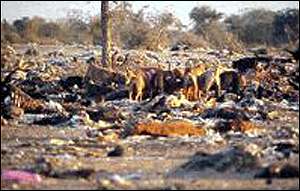
Dogs are the new scavengers, threatening humans and wildlife
(Vibhu Prakash)
Asia's vultures face growing threat Friday, 30 November, 2001, 14:34 GMT By Alex Kirby BBC News Online environment correspondent
The mystery disease decimating two Indian vulture species now appears to be attacking two more.
Conservationists say they think it unlikely the birds will ever recover to their former levels.
They say the scale of the decline is so great that the extinction of at least two species is possible.
The implications for human health, both in south Asia and beyond, are disturbing.
The white-backed and long-billed vultures have for several years been succumbing to a disease which causes their heads to droop, leaves them lethargic and usually kills them within a month.
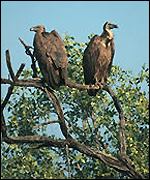 Massive decline
Massive decline
In some areas numbers have fallen by more than 90% within a decade.
Dr Andrew Cunningham, of the Institute of Zoology (IoZ), London, told BBC News Online: "We're almost certain a virus is responsible, and I'm more confident than I was a few months ago that this is an infectious disease, not pollution or poisoning.
"The scale of what's happening is so great these birds are headed for extinction - yet until a decade ago the white-backed vulture was the world's most abundant bird of prey.
"Now the disease appears to be spreading. I did a post mortem in June on a Himalayan griffon vulture, and the pathology was similar."
There are signs the disease is also claiming victims among the country's Eurasian griffons.
Dr Vibhu Prakash, of the Bombay Natural History Society (BNHS), which revealed the problem, said reports from Pakistan and Nepal indicated similar high mortality rates there.
There have been reports of sick vultures from as far away as Saudi Arabia, but they have not been conclusively linked to the Indian outbreak.
Supreme scavengers
The Himalayan and Eurasian griffons, like the two vulture species, belong to the Gyps genus. There are Gyps vultures in southern Europe and throughout Africa.
Dr Debbie Pain, of the UK's Royal Society for the Protection of Birds (RSPB), told BBC News Online: "We're very worried the disease could spread to other griffon species in Europe and Africa, where Gyps are the main scavengers - they eat more meat than all other African predators combined.
"If it reaches Africa it could change the ecology entirely. There'd be a huge increase in animals like hyenas and jackals, and changes in disease patterns, with probable implications for people."
Trapped by dogs
The vultures' decline is already affecting people in India, where feral dog numbers have increased massively to exploit the carcases the birds are no longer eating.
Dr Prakash told BBC News Online: "There's a carcase dump where there used to be 70 or a hundred dogs. I was there recently, and we couldn't get out of the jeep because of the dogs. We counted 1,200 of them.
"They're a big threat to wildlife, and to people. There are reports of them killing children. We believe the incidence of rabies is increasing. And the stench of the carcases round some of the villages is unbearable."
The BNHS, RSPB, the IoZ and the UK's National Birds of Prey Centre are working together to open two centres in India.
One will investigate the disease, and the other will seek to care for vultures in captivity.

Fishermen say reduced quotas will not boost cod stocks
Fishermen face new quota cuts Tuesday, 4 December, 2001, 13:16 GMT Dramatic new cuts in fishing quotas have been put forward by the European Commission, which says stocks of some species are hitting rock bottom.
The heaviest of the proposed cuts would hit the Kattegat strait between Denmark and Sweden, where officials want to axe catches of cod by 60%.
It was another black day for European fisherman, said fisheries commissioner Franz Fischler, but he insisted that tough action was essential.
His other proposals include cutting catches in and around UK waters, including:
Haddock in the Irish Sea by 52% Sole in the North Sea by 25% Plaice off the west of Scotland by 20% Cod in the Irish Sea by 10%
Stocks of all main species, including cod and haddock were now in "an alarming state", warned EU Fisheries Commissioner, Franz Fischler.
He said that, unless drastic action was taken, some species of fish would disappear altogether from the North Sea within two years.
New quotas for North Sea cod and hake will be announced later this month, as negotiations with Norway, Iceland and the Faroe Islands are still going on.
Overcapacity
Mr Fischler said too many boats were still competing for too few fish, and said the European fleet had a "substantial" overcapacity.
"The situation is still alarming," he said.
"We now have our backs to the wall. The stocks are down ad fishing pressure is too high. If we are serious about securing the future of the European Fisheries sector, there is no way around significant reductions of catches and fishing."
European ministers will meet later in December to decide whether to adopt the quotas.
Mr Fischler said they should show "courage and resolve" and go ahead with the cuts to ensure a sustainable industry.
Race to airlift dying turtles Saturday, 29 December, 2001, 00:10 GMT
Sick and cold: 6,000 turtles still need rescuing Conservationists are battling against time to airlift hundreds of sick endangered turtles saved from China's illegal meat trade to a Miami treatment centre.
More than 1,000 of about 10,000 turtles seized by customs officials in Hong Kong over two weeks ago have already died of dehydration, cold or injuries suffered as they were shipped from Singapore and Thailand to mainland China.
The surviving turtles are too ill to be released into the wild, but the Kadoorie Farm and Botanic Garden in Hong Kong where they have been kept until now cannot cope with such large numbers long-term.
"It's getting too cold, many are injured and we don't have the medical expertise to rescue so many. I am afraid many will die if they don't get proper help soon," said a spokeswoman, Idy Wong.
Some tropical turtles are currently living in open pig-pens with temperatures falling below 7C.
About 450 turtles were given free passage on United Airlines flights on Thursday and Friday to the Alapattah Flats Turtle Preserve in Port St Lucie in Miami.
Now Ms Wong is appealing for cargo space to transport 6,000 remaining turtles.
The turtles which have arrived in Miami will be treated and catalogued, before being found new homes by the Turtle Survival Alliance, the animal rights group which has organised the operation.
 Meat trade
Meat trade
"The species we're working with, under the best of circumstances, have a heavy mortality rate, so we're not sure how things are going to look tomorrow morning," said the head vet for the rescue mission, Barbara Bonner.
The consignment of 10,000 turtles, 90% of which are classed as "critical", "endangered", or "vulnerable" species, was estimated to be worth $3.2m.
It included some of the most endangered species in the world, such as the river terrapin, Asian brown turtle, painted terrapin, box turtle and the black marsh turtle.
The reptiles were destined for dining tables in China, where demand is so high that local populations have been exhausted and importers look to countries such as Vietnam and Bangladesh to meet demand.
Conservationists say the animals were travelling in appalling conditions, stacked in styrofoam and cardboard boxes, with the creatures at the bottom of the crates supporting the weight of thousands of others above.
"When we opened up the boxes, turtles at the bottom of the pile were completely smashed," said Ms Wong.
Wildlife smuggling rises in Brazil Tuesday, 13 November, 2001, 00:27 GMT
Brazil's rich wildlife is a magnet for smugglers Wildlife trafficking in Brazil has reached unprecedented levels, with an estimated 38 million wild animals stolen from the country's forests every year, according to a new report.
Brazil's National Network Against the Trafficking of Wild Animals (RENCTAS) says local traffickers made up to $1 billion dollars a year from the sale of rare animals to foreign collectors.
Birds represent up to 82% of sales, while mammals represent 14% and snakes 3%.
Wildlife smuggling is now, according to RENCTAS, the country's third most profitable activity after arms and drug smuggling, which generate between $10 to 20 million in illegal revenue.
Widespread poverty, lack of education and the temptation of high profits despite often great risk are all cited as primary reasons for Brazilians entering the animal trafficking industry.
Lucrative market
Brazil's vast Pantanal wetlands provide smugglers with a rich source of rare animals and plants.
The survey provides detailed maps of the smugglers' routes in and out of the hotspots, and notes that only a miniscule amount of animals, some 0.45%, are successfully intercepted by Brazilian police.
 Locally, birds such as parakeets
and parrots can fetch up to $100 on street markets and town fairs.
Locally, birds such as parakeets
and parrots can fetch up to $100 on street markets and town fairs.
However the international markets remains by far the most lucrative for would-be smugglers, where an extremely rare Lear's macaw can fetch up to $60,000 and a Jaguar's skin up to $20,000.
The biggest buyers include the United States, Germany, the Netherlands, Belgium and France. RENCTAS said that only 10% of such animals survive the trips overseas.
The Brazilian government, which received a copy of the report, said that it planned to extend an operation initiated in the Minas Gerais state to encourage Brazilian consumers not to buy smuggled animals that found their way onto local street markets.
"Trafficking in wildlife is a threat to life itself," said Brazilian Environment Minister Jose Serra Filho.
 Antarctic
penguins in peril Saturday, 12 January, 2002, 04:24 GMT By
the BBC's Ania Lichtarowicz
Antarctic
penguins in peril Saturday, 12 January, 2002, 04:24 GMT By
the BBC's Ania Lichtarowicz
Tens of thousands of baby penguins could starve to death as their parents are having to walk up to 50 kilometres further than usual to get food.
The normal route to feeding areas is blocked after two giant icebergs broke off the Antarctic Ice Sheet and are now floating between the Ross Island and the open ocean.
Almost 150,000 breeding pairs of Emperor and Adelie penguins are finding it increasingly difficult to feed their chicks.
Two huge ice blocks - one the size of Jamaica - broke off the vast Ross Ice Shelf, south of New Zeland, in March 2000. They have now floated between Ross Island - where the penguins breed - and Franklin Island, blocking short routes to the open sea.
Energy used up
Penguins come ashore to breed, then take it in turns to go hunting for food like fish, crustaceans and squid.
They walk at a pace of less than two kilometres an hour and they are now having to travel up to 50 kilometres further than usual.
This means when they return to their young they have little food left to regurgitate for them as they have used so much energy making the round trip.
Antarctica New Zealand, the government-funded organsation which has been monitoring the situation, says that up to 20,000 chicks could die as the ice blocks are almost completely impassable.
Scientists say that some animals have already abandoned the Ross Island colonies to try to breed elsewhere.
Tuesday, 15 January, 2002, 01:15 GMT Caspian sturgeon stocks plummet
The Caspian supplies up to 90% of the world's caviar By the BBC's Chloe Arnold in Baku
Caviar, a highly prized delicacy produced from the eggs of mature sturgeon, could be in danger of vanishing from the shelves of up-market stores in the West.
The biggest-ever scientific survey looking at sturgeon populations in the Caspian Sea has revealed that the fish are rapidly disappearing and could soon become extinct.
Four of the five Caspian states took part in the survey last year - the most in-depth look yet at sturgeon numbers in the Caspian Sea.
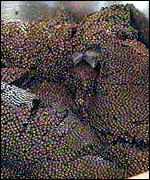 Scientists from Azerbaijan, Kazakhstan,
Iran and Russia spent six weeks trawling across the sea using
state-of-the-art radar equipment from Norway to monitor the fish.
Scientists from Azerbaijan, Kazakhstan,
Iran and Russia spent six weeks trawling across the sea using
state-of-the-art radar equipment from Norway to monitor the fish.
They said the most worrying finding was an abnormally large proportion of young sturgeon in comparison to more mature fish.
It is the older sturgeon that produce the eggs used to make caviar - known here as black gold - and as a result they are being over-fished.
The survey also reveals alarmingly small numbers of beluga fish, the rarest species of sturgeon.
Poachers' lucrative trade
The Convention on International Trade in Endangered Species has ordered a partial moratorium on fishing for sturgeon in the Caspian Sea.
But experts say this will do little to stop poaching, which is thought to exceed official catch levels by up to 15 times.
Caviar smuggling is a lucrative business in the impoverished former Soviet republics, as the roe fetches up to US $1,000 a kilogram in the West.
The Caspian is the source of 80-90% of the world's caviar, but for the last 20 years, sturgeon numbers have been falling steadily.
Monday, 14 January, 2002, 16:13 GMT Whale farm plan lambasted
Catching whales for life in captivity could prove difficult Environmentalists have described ideas for the world's first whale farm off the coast of Japan as "preposterous" .
Richard Page of Greenpeace International told BBC News Online that trying to farm whales was "totally unfeasible" and posed all sorts of difficulties - from feeding the large animals to making them reproduce in captivity.
He said the publicity surrounding the project was a way of diverting the public's attention from Japan's controversial whale hunting activities in Antarctica.
The town of Hirado in south-west Japan says it is planning to set up a whale farm to entertain tourists and study the animals behaviour and breeding patterns.
Local officials were quoted by Japanese media as saying they were planning to trap minke whales in nets and bring them into a whale reserve covering five square kilometres (two square miles) of waters off the town's shores.
The farm then would try to breed minke whales for research purposes and later develop facilities for whale watching.
It remains unclear whether some animals would be killed to provide meat for Japanese restaurants.
The town of Hirado, about 1,000 kilometres southwest of Tokyo, was famous for its whaling industry until World War II.
The idea to revive that tradition was first reported in Japanese media last year and has been warmly welcomed by Japan's Institute of Cetacean Research.
Its director general, Seiji Osumi, said last week that the farm would be the realisation of a dream that could provide precious scientific data.
"There are many things unknown about whales, and we will be able to carry out research on their behaviour," he said.
But critics like Greenpeace's Richard Page said the idea was "ludicrous" and the difficulties of farming minke whales were enormous.
"We know very little about where minke whales breed", he said, adding that there was no guarantee that they would mate and calve in captivity.
 Feeding problems
Feeding problems
"Minke whales are a highly migratory species and travel long distances; in captivity they won't behave normally," he said.
There is the additional challenge of feeding the large mammals.
Although minkes are the smallest of the great whales, they still can weigh up to nine tons and reach 10 metres (32 feet) in length in maturity.
They eat up to 200 kg of fish per day.
Japan's stance on whaling has been the focus of international criticism for years.
A Japanese fleet is currently on an expedition in Antarctica to harvest 440 minke whales - despite a global ban on whaling introduced by the International Whaling Commission.
Legal loophole
For years, the government in Tokyo has been using a loophole in the IWC rules that allow "scientific whaling" - but critics of Japan's position say that is just a pretext for bringing back commercial whale hunting.
Whale meat is considered a delicacy in Japan, and meat from the scientific expeditions is sold to restaurants.
While organisations like Greenpeace say the number of minke whales has declined sharply over recent years, Japan says they are abundant in the Antarctic.